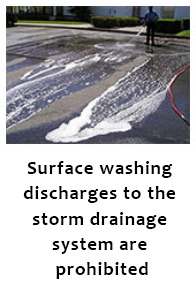 The Storm Drainage System:
The Storm Drainage System:
The storm drainage system prevents flooding by allowing developed areas to drain into local waterways. This system includes storm drains located in the public right–of-way, as well as those on private property (because they convey drainage to the municipal system), underground pipes, roadside drainage ditches, roadside gutters, drainage channels, creeks, streams, and any man made or natural structure that conveys storm drainage. The storm drainage system is different from the sanitary sewer system that conveys sewage to the treatment plant. Note: drain inlets located outdoors almost always lead to the storm drain system!
No Dumping - Flows to the River:
Unlike discharges to the sanitary sewer system that receives treatment, storm drainage receives no treatment for pollutant removal. Pollutants discharged to the storm drainage system flow directly into our local waterways. Oil and grease, food waste, paint, concrete, chemicals, even sediment, must be prevented from getting into the storm drainage system and local waters.
Stormwater Runoff:
When pollutant sources are exposed to rainfall, they can be washed into the storm drainage system and local waters. Some examples are oily engine blocks or leaky waste oil containers that are left outdoors; food waste on the ground around a dumpster; sediment; liquids or powdery materials that are tracked outdoors by forklifts and other vehicles from an indoor process area, and even leaky vehicles, equipment, compressors, etc. These materials and wastes can be washed into the storm drainage system and local waters by rainfall, sprinklers that run too long, dust suppression systems, employees pressure washing paved areas, and other sources of runoff.
Stormwater Runoff Pollution Awareness
Many businesses conduct activities that contribute to the degradation of local waters, often without realizing it. For example, restaurants and other facilities that handle food generate grease and other food wastes. Greasy mop water discharged by employees to a storm drain and food waste liquid leaking from a dumpster are two examples of how pollutants may be discharged to the storm drainage system that leads directly to area creeks and streams.
Automotive fluids such as antifreeze and engine oil are common pollutants of concern at facilities that are involved with auto repair. These pollutants may be intentionally or accidentally dumped or washed into the storm drain by uninformed employees. Pollutants may also be washed into the storm drainage system when rainwater comes in contact with outdoor spills, oily parts left outside, and other contaminated surfaces.
There are many pollutant sources associated with other business activities, as well. Other common pollutants include:
- Concrete, concrete dust, and concrete contaminated sediment
- Concrete rinse and wash-out water
- Commercial vehicle wash water
- Sediment
- Pressure washing and surface cleaning wastewater
- Paint rinse water
- Chemicals that leak or are spilled or dumped
- Hydraulic fluids and other leaking vehicle and equipment fluids
Back to Storm Water main page
